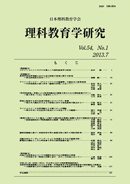Volume 54, Issue 1
Displaying 1-11 of 11 articles from this issue
- |<
- <
- 1
- >
- >|
Review Paper
-
2013Volume 54Issue 1 Pages 1-11
Published: July 17, 2013
Released on J-STAGE: August 09, 2013
Download PDF (484K)
Original Paper
-
2013Volume 54Issue 1 Pages 13-26
Published: July 17, 2013
Released on J-STAGE: August 09, 2013
Download PDF (1186K) -
2013Volume 54Issue 1 Pages 27-36
Published: July 17, 2013
Released on J-STAGE: August 09, 2013
Download PDF (2275K) -
2013Volume 54Issue 1 Pages 37-49
Published: July 17, 2013
Released on J-STAGE: August 09, 2013
Download PDF (877K) -
2013Volume 54Issue 1 Pages 51-59
Published: July 17, 2013
Released on J-STAGE: August 09, 2013
Download PDF (5440K) -
2013Volume 54Issue 1 Pages 61-69
Published: July 17, 2013
Released on J-STAGE: August 09, 2013
Download PDF (6056K) -
2013Volume 54Issue 1 Pages 71-81
Published: July 17, 2013
Released on J-STAGE: August 09, 2013
Download PDF (1071K) -
2013Volume 54Issue 1 Pages 83-92
Published: July 17, 2013
Released on J-STAGE: August 09, 2013
Download PDF (1435K) -
2013Volume 54Issue 1 Pages 93-104
Published: July 17, 2013
Released on J-STAGE: August 09, 2013
Download PDF (1199K)
Research Paper
-
2013Volume 54Issue 1 Pages 105-115
Published: July 17, 2013
Released on J-STAGE: August 09, 2013
Download PDF (2095K) -
2013Volume 54Issue 1 Pages 117-126
Published: July 17, 2013
Released on J-STAGE: August 09, 2013
Download PDF (851K)
- |<
- <
- 1
- >
- >|
